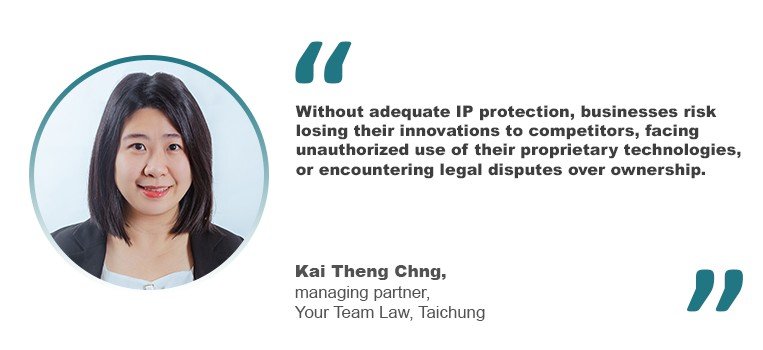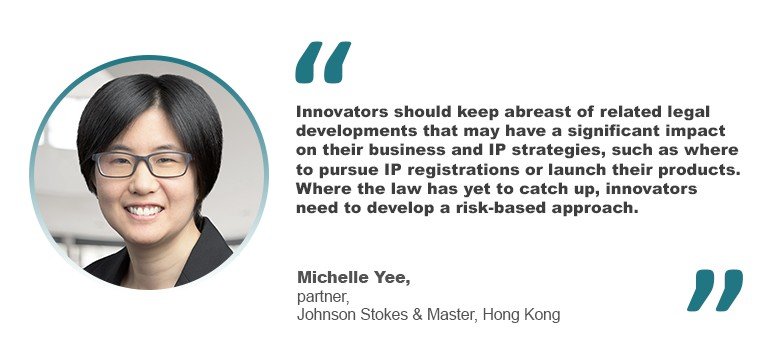“Without adequate IP protection, businesses risk losing their innovations to competitors, facing unauthorized use of their proprietary technologies, or encountering legal disputes over ownership,” said Kai Theng Chng, managing partner at Your Team Law in Taichung. “A well-structured IP strategy enables companies to secure their technological advancements while maintaining market exclusivity.”
Michelle Yee, a partner and head of brand management at Johnson Stokes & Master in Hong Kong, added: “Having strong IP protection over their supply chain technology gives businesses a competitive edge in the market, whether to keep it in-house or license them to third parties and take enforcement action against infringing use where necessary. In the long run, investing in IP protection allows businesses to gain a competitive edge in the market, continue to build their IP portfolio for greater innovation, and give confidence to investors and customers.”
Challenges in the supply chain
In securing IP rights in the supply chain sector, companies may encounter several of these issues.
Rapid technological evolution. Supply chain innovations often evolve faster than traditional IP protection processes can accommodate. The window between invention and obsolescence is shrinking, making it difficult to secure long-term protection.
Complexity of patentable subject matter. Many innovations in supply chain management – especially software algorithms and data-driven processes – can be challenging to categorize under existing patent frameworks. Jurisdictions differ in their interpretation of what is patentable, adding layers of complexity.
Global jurisdictional differences. With supply chains spanning multiple countries, companies must navigate a patchwork of IP laws and enforcement mechanisms. Securing protection in every relevant market can be both costly and administratively burdensome.
Risk of reverse engineering and cyber threats. As supply chain technologies become more interconnected and digitized, they are increasingly vulnerable to reverse engineering, hacking or inadvertent leaks. Maintaining the secrecy of critical innovations such as proprietary algorithms is a constant challenge.
Open-source and collaboration challenges. Many supply chain technologies integrate open-source software or involve multi-party collaborations, raising concerns about ownership and IP rights management.
Chng said: “Addressing these challenges requires proactive IP management and a strategy that aligns with the company’s innovation cycle and global operations.”
“Taking patent rights as an example, obtaining a patent gives the owner strong rights to exploit an invention,” added Yee. “At the same time, pursuing a patent registration requires advance planning and a substantial amount of time and cost – which may or may not be better applied towards developing new solutions and keeping up with the changing technology landscape.”
The increasing complexity and spread of the supply chain network also adds to the challenge. According to Yee, the more stakeholders and jurisdictions involved, the more areas where companies need to safeguard their IP rights and be vigilant against unauthorized or infringing use of their technology and leaking of trade secrets and other confidential information.
Taking a proactive approach
While protecting IP rights in the supply chain sector can be complex, it is important to note that businesses should adopt a proactive approach by conducting an audit of their IP portfolio. This includes reviewing their IP registrations and policies; identifying any gaps in coverage and IP assets that have been overlooked; gaining clarity of their internal and external IP licensing structures; and reviewing template agreements with external parties.
“Once the gaps and pain points are identified, businesses can make an informed and strategic decision on appropriate areas of focus,” said Yee. “For example, if a supply chain solutions software developer relies primarily on copyright and trade secret protection, it may want to strengthen the IP and confidentiality clauses in its employment and commission agreements as a matter of priority and ensure these are watertight. It may also want to review its due diligence practice and non-disclosure agreements (NDAs) with partners and clients.”
Effective and timely monitoring and enforcement action are equally important. In addition to implementing technical measures such as encryption and anti-counterfeiting technology, businesses could consider engaging patent and trademark monitoring services, conduct regular checks on partners, clients and the market for anomalies or potential misuse of IP rights.
“Businesses should also have a clear understanding of their contractual rights,” said Yee. “For example, a company which is not familiar with its audit rights in its licence agreements could be losing substantial royalties and damages, but also the opportunity to take early action against breaches and infringement.”
Chng also gave her insights into how businesses can protect their IP rights:
-
File for patents, trademarks or other forms of protection in all key markets where the product will be used or where competitors might operate. Specifically, using a blend of patents for technical inventions, trademarks for branding and trade secrets for those special formulas or algorithms.
-
Maintain clear records of innovation developments, including research notes, prototypes and technical disclosures, and strengthen the ability to establish ownership and defend against infringement claims.
Future-proofing businesses
Not only is taking a proactive approach important for companies, but they also need to have a good grasp of the common types of IP rights in their field to allow for early identification of where and how to protect their rights in emerging or evolving technologies. This includes knowing the time and cost involved in pursuing each type of IP right and the preparation required. An example is to pave the way for a patent application by using NDAs to preserve the novelty of an invention, knowing the prior art in the relevant field, and seeking advice on the intricacies of effective patent drafting in jurisdictions of interest. Also, companies should have robust template IP agreements that can be tailored to each case.
“Being prepared and alert to such matters will enable a company to respond quickly to changes in technology in a way that is consistent with its particular business and IP strategy and to effectively address any gaps in its IP portfolio,” said Yee.
She added that emerging trends such as AI and blockchain technologies may not fit perfectly into existing IP frameworks, and the regulations relating to the scope and nature of protection of emerging technologies are constantly evolving as regulators in different jurisdictions grapple with the myriads of novel issues presented by such technologies. For example, the extent to which inventions developed by AI are protectable by copyright or patent and disclosure obligations relating to the use of AI in patent applications differ across jurisdictions.









